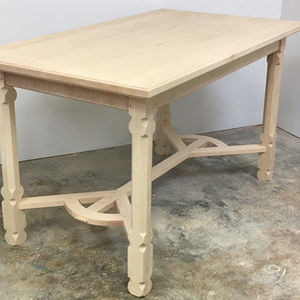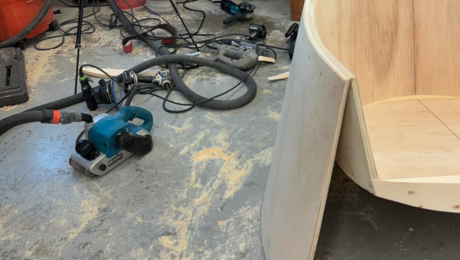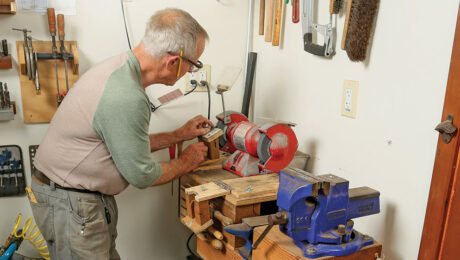10 Tips for Going Pro
When you're ready to hang out your own shingle, follow these hard-won lessons from a successful custom furniture-maker
My transition from lawyer practicing civil litigation to professional craftsman making fine furniture did not come without risk, stress, strife, and cost, especially opportunity cost. When asked to give advice to those contemplating the same leap, I feel sick to my stomach because I recall the struggles I endured to make it to the other side. On the other hand, I’ve never regretted the move.
My life is better now than I ever could have imagined, but it has been a difficult road to make woodworking pay. A lot depends on the skills you bring to the table, the area in which you live, and the resources available to you. If I could give only one suggestion it would be to spend as much time and effort marketing as improving your woodworking skills.
In my decade as a woodworking professional I’ve learned these lessons the hard way. Take them to heart and the process will be much easier for you.
|
10 Important Lessons |
|
1: Design what others want, not what you want Custom designs are a win-win for you and your clients. |
| 2: Time is the one thing you can never get back Don’t spend huge amounts of time trying to land a single, low-ticket sale. The public craves free advice wherever it can get it, from free quotes to free design sessions. Unless a prospective client is serious about spending money, be careful about how much free time you give to them. Don’t be afraid to charge for your time. Plumbers charge for house calls; mechanics charge to diagnose car troubles. Instead of free quotes, offer paid in-home “consultations;” instead of free repair estimates, paid “professional repair reports.” I used to dance around the subject of pricing for hours, believing that it should be the last thing discussed or “negotiated.” That often meant learning at the end of the meeting that the client had a budget of $1,000 and my price had to be $3,000 or more. Now, as soon as we start talking, I steer clients to my Web site to show them the pricing. That saves me a half-day of completely wasted time. If a client can’t afford my prices, I won’t get that job no matter how much talking or convincing I try to do. |
3: Don’t be shy If you don’t toot your own horn, nobody else will. Learn to market well and the rest will follow. Be an active and shameless promoter of your business. Invest in a good Web site, send press releases to the local media, write for magazines, and join your local chamber of commerce. Rivals who criticize your relentless marketing efforts will simmer down when they realize you have a business that works–especially if it’s a business they have always wanted but didn’t have the courage to try. If you don’t toot your own horn, nobody else will. Learn to market well and the rest will follow. Be an active and shameless promoter of your business. Invest in a good Web site, send press releases to the local media, write for magazines, and join your local chamber of commerce. Rivals who criticize your relentless marketing efforts will simmer down when they realize you have a business that works–especially if it’s a business they have always wanted but didn’t have the courage to try.Networking pays dividends. |
| 4: Be wise about marketing materials I’ve seen Web sites promoting high-end custom furniture that included pictures of the owner’s dog, the owner’s child sweeping the shop, half-painted walls, and piles of sawdust everywhere. Do your clients need to see your workshop? What might be quite impressive to a woodworking hobbyist can look downright nasty to a wealthy buyer. If you’re building custom furniture, travel to the client’s home for the initial consultation and let the quality of the furniture speak for itself. |
|
5: First impressions mean everything |
| 6: Flea markets and fairs are not for you Don’t waste your time at flea markets trying to sell inexpensive items. You can’t build them fast enough in a one-man shop to compete with off-shore imports. You’re convinced that your products will sell for a higher price because they are made of better quality materials at a higher level of craftsmanship. They won’t. People who shop at flea markets are looking for deals, not necessarily quality. Some of the largest retail operations in the world flourish while selling cheap products to masses of people. Don’t even try to compete on that level. I remember standing on the hay-covered floor of a farm building, trying to sell high-end furniture at a local fall fair. I don’t know if I looked like an idiot, but I sure felt like one. I received never-ending praise from those walking by, but not one person opened his or her wallet. I found out the hard way that people usually aren’t in the mood to buy fine furniture right after they get off a stomach-churning amusement ride. |
| 7: Price doesn’t determine whether a product will sell I am convinced that I’ve lost jobs because I didn’t quote as high a price as the prospective client expected. Charge what you are worth on a real-world pay scale and see what happens; your success will depend more on marketing than on the product itself. Of course, you must have a high-quality product, but be sure to charge enough for it to be taken seriously by your target market. |
|
8: Rein in expenses |
9: Diversify to survive I started my business thinking that any work other than designing and building furniture was beneath me. I turned away refinishing jobs, antique restoration, and furniture repair work. Almost starving has a way of waking you up to the reality of the marketplace. In later years, some of these services were the only kinds of work that kept me afloat. I now offer a consultation service, on-site finish repair, insurance and litigation reports, woodworking seminars, private courses, and more. Financial planners tell us to diversify our portfolios so as not to put all our eggs in one basket. Likewise, diversify the services you offer. I started my business thinking that any work other than designing and building furniture was beneath me. I turned away refinishing jobs, antique restoration, and furniture repair work. Almost starving has a way of waking you up to the reality of the marketplace. In later years, some of these services were the only kinds of work that kept me afloat. I now offer a consultation service, on-site finish repair, insurance and litigation reports, woodworking seminars, private courses, and more. Financial planners tell us to diversify our portfolios so as not to put all our eggs in one basket. Likewise, diversify the services you offer.
Offering a range of services helps you ride out marketplace cycles. |
| 10: Don’t let anyone tell you that you can’t succeed You’ll hear this kind of thing in just about any industry: “Don’t enter the computer field; there is glut on the market;” “Don’t become a lawyer, there are too many already!” (Well, that one might be true). If you’re good at what you do, your head will rise above the crowd and people will notice you. Perfect your craft, work hard, and market hard. You can and will make the business work if you want it badly enough. |
At www.passionforwood.com, you can purchase Hendrik Varju’s book, “Starting and Running a Woodworking Business” ($50 Canadian), which includes 30 minutes of individual telephone consultation.
Fine Woodworking Recommended Products

Suizan Japanese Pull Saw

 You decide you have the latest and greatest product to hit the market: a designer paper towel holder. Convinced it will be a hit, you make 100 in different species of wood, with lots of inlay, routed details, and so on. You sign up for craft show after craft show, only to find that nobody wants a fancy paper towel holder, or at least not at the price you require to earn a living making it. This is a product the buying public just doesn’t care about. But by offering custom design, you let paying clients dictate the kind of work they want.
You decide you have the latest and greatest product to hit the market: a designer paper towel holder. Convinced it will be a hit, you make 100 in different species of wood, with lots of inlay, routed details, and so on. You sign up for craft show after craft show, only to find that nobody wants a fancy paper towel holder, or at least not at the price you require to earn a living making it. This is a product the buying public just doesn’t care about. But by offering custom design, you let paying clients dictate the kind of work they want.




















Log in or create an account to post a comment.
Sign up Log in